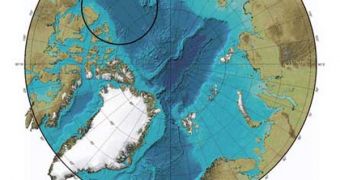For the past 12 years, a pool of freshwater has been forming in the Arctic Ocean, experts say. The cause for this amazing phenomenon is unknown, but what experts were able to determine is that water brought into the area by rivers no longer mixes with saltwater.
This is generally how things work – rivers bring freshwater into the salty oceans, where the two types of water mix. The process replenishes the amount of water that was lost from the seas via evaporation.
According to experts, this is a natural part of the cycle of water on our planet. Yet, for some reason, the process appears not to be taking place in a specific area of the Arctic Ocean. In that region, the freshwater brought on by rivers accumulates nearly unmixed with surrounding saltwater.
This happens in the Beaufort Gyre, off the coasts of northern Canada. According to experts at the Royal Netherlands Institute for Sea Research, in Texel, the phenomenon could be caused by a pattern of strong winds that continue to blow clockwise in the region.
RNISR physical oceanographer Laura de Steur says that these winds have basically closed off around 7,500 cubic kilometers of water in the region, preventing waters from mixing naturally.
Current estimates show that the freshwater pool is nearly two times larger than the volume of Lake Victoria, in Africa. This is one of the largest bodies of freshwater in the world, Science News reports.
Scientists know that wind patterns can cause such effects, or even their exact opposites. Strong winds are also responsible for excessive mixing of freshwater and saltwater, de Steur explains. But previously, wind patterns only endured for 5 to 8 years, and not 12.
“Freshwater is not really something that marine organisms can tolerate. [If plankton comes across such a pool,] you could expect that there would be very large mortality,” says Institute director Carlo Heip.
He is also the coordinator of Project CLAMER (Climate Change and European Marine Ecosystem Research), which involves 11 European countries and 19 research organizations. The expert explains that having freshwater in this areas of the Arctic is very dangerous for other reasons as well.
This pool could make its way into the North Atlantic Ocean, where the North Atlantic heat conveyor belt converts elevated water temperature into atmospheric heat, which is then spread over Europe.
In the past, when the conveyor belt stopped, the Old Continent was covered in ice from north to south, including on the shores of the Mediterranean Sea. We simply cannot afford to let that happen again.
Scientists acknowledge the importance of such studies, and are now keeping a close eye on the freshwater pool developing in the Arctic Ocean. They say that any changes in the current situation would be quickly discovered.

 14 DAY TRIAL //
14 DAY TRIAL //